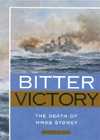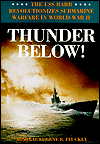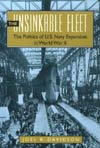Bitter Victory
The Death of HMAS Sydney
Olson, Wesley
2000, University of Western Australia Press
ISBN 1876268492
Hardcover, 436 pages, 42 b&w photos, maps, diagrams
| Type. | General History |
| Pros. | New, narrative and analytical, lays to rest conspiracies and actually tries to resolve many difficult issues. Gives a brilliant picture of the times, men, ships, and events. |
| Cons. | None |
| Rating. |  |

Wesley Olson's Bitter Victory: The Life & Death of HMAS Sydney is a brilliant work. It is in fact the book that Tom Frame's HMAS Sydney: Loss & Controversy ought to have been. Olson's book is equally solid, well researched, deftly written, and sensitive to the trauma and relatives' feelings. He does not shy from judgement, nor from informed speculation, which is among the most careful and effective in published naval accounts. Olson illustrates for us what may have occurred and how it might have been experienced in HMAS Sydney that fatal day. He dismisses the conspiracies by evaluating all the sources, and narrating a smooth but still studied account. This work, unlike Frame's, benefits from both the traditions of official and academic naval history, and more commercial and general accounts. It feels complete to read, a rare achievement for a historical work. The 'grit' of the story is here.
This is not a book for conspiracy theorists. They cannot be satisfied. It is instead reasonably intended for the rest of us, both those who know nothing, and those who don't yet know enough. Enough of the answers are here for us to be satisfied that no deeper search is required. This book enables the rest of us not to have to do the same basic repetitive research ourselves. Olson has combined primary, secondary and other sources, with the latest official Australian Government investigations, to prove what happened as far as sources go, and weigh the imponderables aboard Sydney after Kormoran crippled her and they drifted apart. It is in the weighing of those imponderables so avoided by Frame that Olson really outshines his much senior colleague.
By doing so Olson has moved into the tricky territory of counterfactual history: into the area of speculation and imagination. It is all the more to his credit that he has been restrained and realistic. Olson has conducted a deep, careful, forensic investigation. He has assessed the oral history of the coastal residents, the faked reports purporting to come from documents recovered from wreckage, and the other less creditable sources. He has also finally given us a picture of what the damage caused by Kormoran did aboard Sydney, based on German eyewitnesses, and thus a fair picture of what happened: the fires, the loss of services and personnel, the reasons for her loss almost without trace bar a few lifebelts and one controversially damaged raft. There was no neutrality-breaking Japanese submarine, no Vichy vessel, nor any real incompetence aboard Sydney. There was indeed even little need for subterfuge or treachery aboard Kormoran, though a little may have been used to get a few moment's lead in firing first. Within the range of Kormoran's guns, almost the same calibre as Sydney's, it was initially a very even fight. As with most maritime mysteries, the actual events are merely the complex collision of an unseen set of factors.
The book is strongly bound, well printed, and contains a wealth of technical information, essential to understanding the ship, her operations, and the damage she suffered. There are a great number of images: photographic, line, sketch and silhouette, of Sydney, Kormoran, and other similar vessels. There are a bevy of maps and charts illustrating and enhancing every section of the text. The book commences with a description of the loss of Kormoran and the rescue of her survivors. This is followed by a lengthy but clear discussion of the design and construction of HMAS Sydney, followed by an analysis of the war at sea, and Kormoran's career, as well as those of the commanders. The analysis proceeds to the following search for Sydney, the histories and investigations, theories and conspiracies. These are concluded by an analysis of the damage and probable causes of Sydney's loss. Nothing is left out, and nothing left to chance.
What is most surprising and rewarding is Olson's own position. A former labourer and driver, with no naval experience and some military service, he turned under the guidance of other historians to writing naval history in early middle-age, and has produced a well-written, well-researched, unprejudiced, effective book, at just the right time, with the perfect balance of technical, operational, personal, anecdotal and photographic evidence. As such his book, despite its relatively inexperienced parentage, stands heads above all the other works: the poor patriotic early accounts, the limited official ones, the works like Barbara Winter's focussing on Kormoran, the mendacious conspiracy theorists, and the recent, solid but unimaginative such as Frame's. As a work of naval history and as a work by a comparative beginner this is an amazing achievement. Olson was admittedly working with the advantage of Frame and others before him, both as reference and guide. As a result Olson has been able to do much of the speculatory and imaginative work Frame could and would not do. Olson has produced a much fuller, deeper account, not only describing the ship and the events, but also a set of reasonable conjectures as to the damage to and fate of Sydney and her crew. He is able to dismiss the bogus reports and accounts offered in the 1950s, and sum up both the official Australian Government report on the tragedy, and all previous works. That should not however have precluded Frame from using his own existing skills and abilities to do much of this.
Unlike Frame, Olson has taken the bold and commendable step of going into the events, supposing in a masterful way, and giving both the relatives and everyone else the kind of view into the events and the horror no-one else has dared or bothered to do. Describing the possibilities in a restrained and non-sensational tone, he has allowed everyone to see, and feel, the terror and pain of that awful night, and given those still grieving a traumatic but therapeutic experience. Perhaps by coming to a considered, unsentimental and realistic understanding of what might have happened, and why therefore no wreckage or survivors were found, both the conspiracies and the doubt may be laid to rest. Real healing and atonement can result. Olson has done more to relieve and comfort the trauma and grief by his method than any previous historian of the Sydney-Kormoran disaster. It can only be hoped that this work alone may cut through decades of abuse and misuse by historians, relatives, conspiracists, journalists, hacks, and others. It must also be hoped his next work may set an equally high standard of scholarship and perspective on another topic. This really is "the book you've been waiting for", according to Mike McCarthy of the W.A. Maritime Museum.
The reviewer welcomes your comments on this review.
Review written by Ian Campbell, Launceston, Tasmania.
Published on 4 Jun 2001.
This title is highly recommended.
Purchase information: (info) Get Bitter Victory now at amazon.co.uk
Get Bitter Victory now at amazon.co.uk
Return to our main review page.



